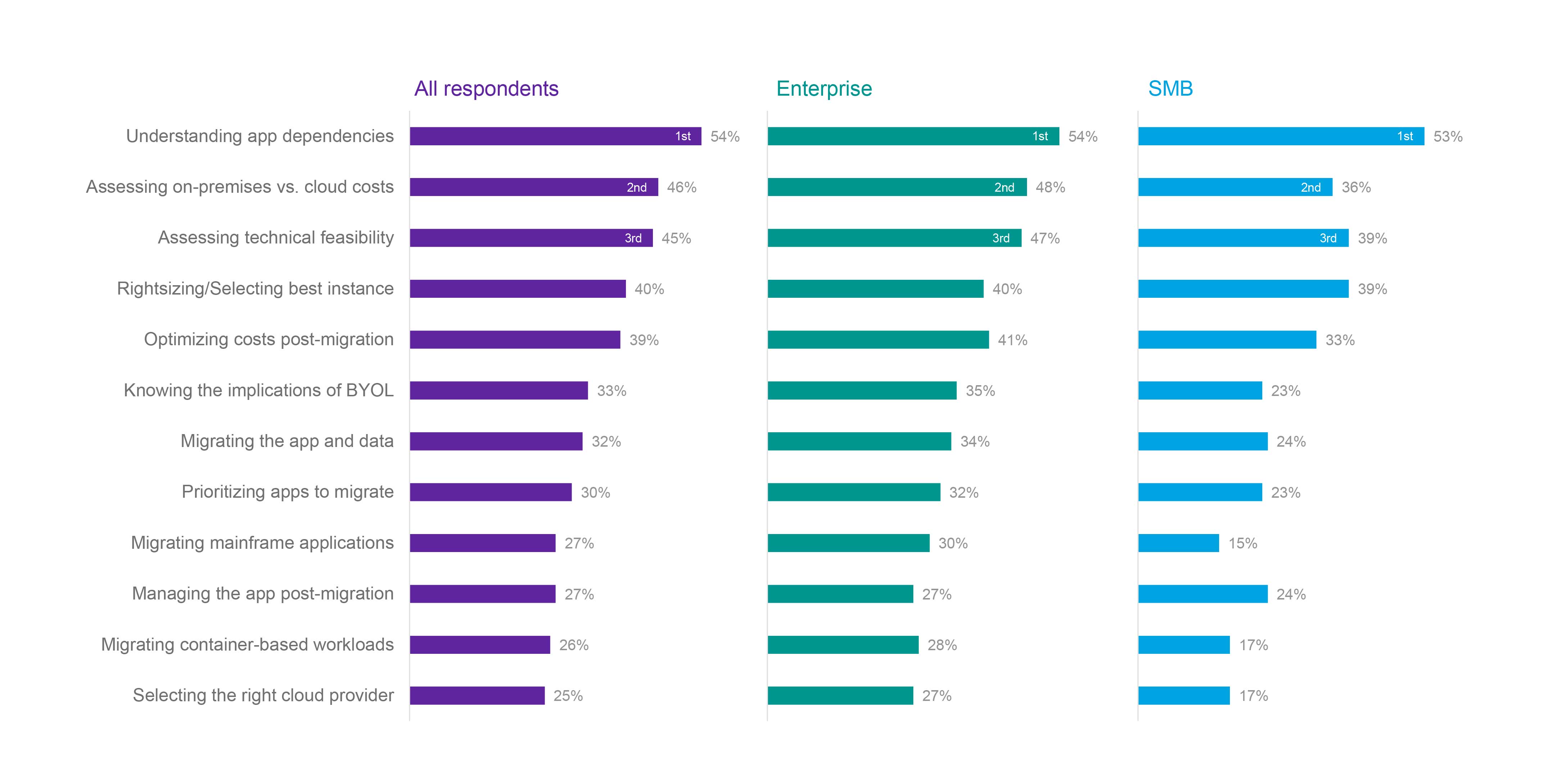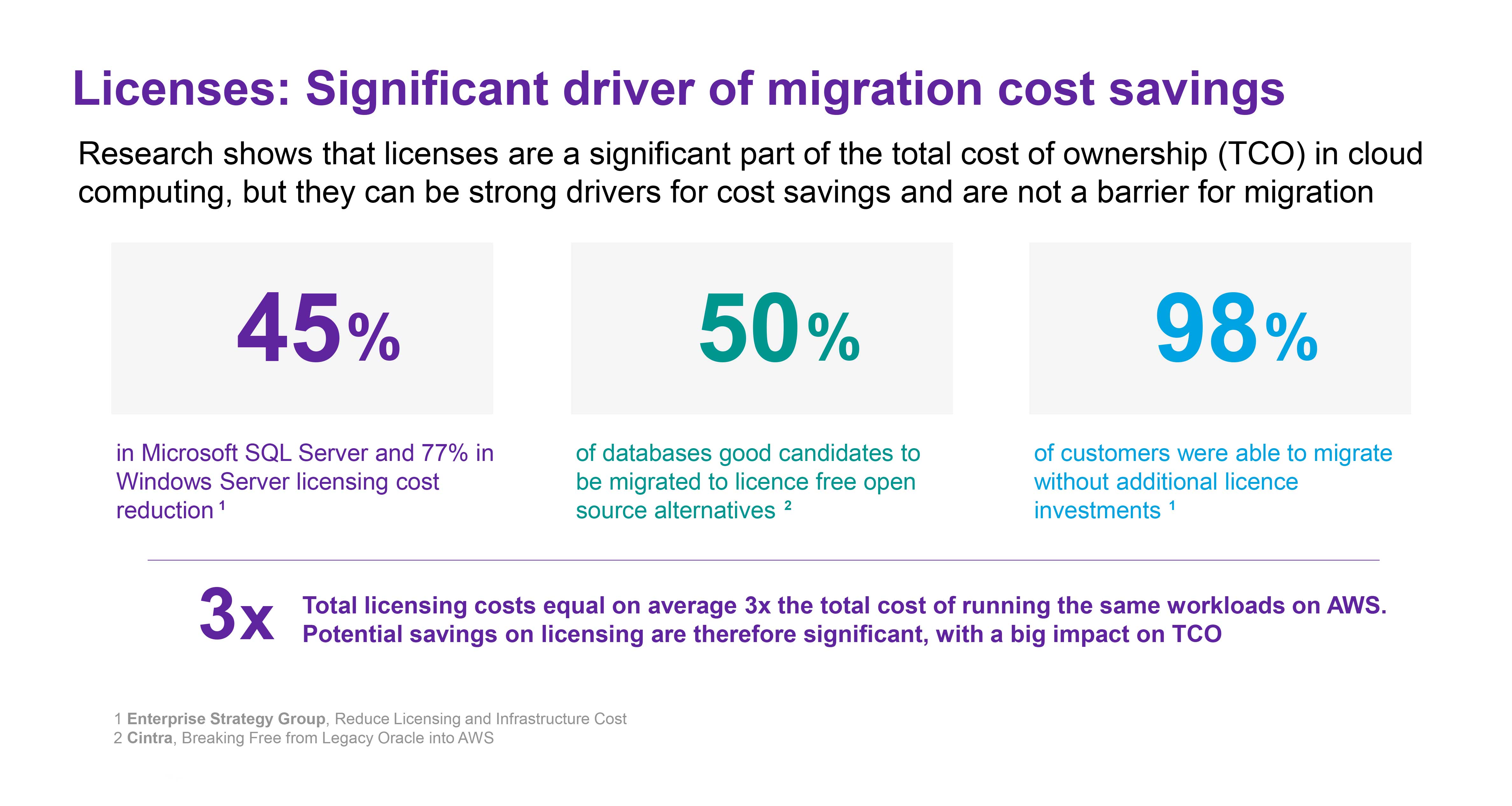In brief
- Key factors that impact cloud migration costs include workloads to move, their cloud readiness, data volumes, the selected cloud service model and vendor, security and compliance needs, expected downtime and disruptions, and required talent
- Cloud migration costs can be direct and indirect. Direct costs include cloud consumption, labor, and software licensing costs. Indirect costs span additional training, downtime and disruptions, and organizational changes
- You can optimize cloud migration costs by having the right migration strategy and treatment, typically from the “7 Rs”, for each workload, leveraging discounts and migration incentives, properly designing the landing zone, adopting open-source software solutions when possible, adopting hybrid cloud models where appropriate and establishing FinOps as a practice from the beginning of the migration
- Post migration costs can also be optimized through FinOps best practices, continuously rightsizing resources, continuous improvement of application architectures, reserved instances or compute savings plans and optimizing the usage of on-demand environments for non-production
Does it make financial sense to move your workloads to the cloud? Will it be cheaper than maintaining the status quo? And how much will you have to invest in migration, exactly?
Answering these questions – and avoiding cost overruns – requires a sound, realistic cloud migration cost estimate. But it’s easier said than done.
Small businesses, medium-sized ventures, and large enterprises all have one thing in common: they struggle with assessing the cost-efficiency of moving to the cloud. According to Flexera’s 2024 State of the Cloud Report, this is among the top three challenges for businesses of all sizes.

Not all cloud migration costs are obvious, of course. Here’s what impacts those costs – and how to keep them minimal.
What influences cloud migration costs?
To come up with a cloud migration cost estimate, you need to take into account the following nine factors.
Workloads
The more workloads you have to transfer to the cloud environment, the costlier migration will be. The same rings true for the complexity of those workloads: the higher it is, the more you’ll have to pay to migrate them.
Data volumes
Cloud service providers typically charge for data egress. These data transfer costs can be high when in a hybrid mode, or with unoptimized integration patterns, reducing the competitiveness of cloud infrastructure. One major mitigation for this is clustering workloads into waves, where heavily interconnected applications with a lot of inter-application data transfer are migrated together, reducing the amount of data egress and data transfer costs.
Cloud readiness
The workloads you wish to migrate may not be ready to move to the cloud as-is. If that’s the case, you’ll need to invest resources into tweaking, upgrading or replacing those applications before migration as part of your cloud migration strategy.
Here are the seven common migration strategies (the 7 Rs) based on workload cloud readiness, from the least to the most complex on average:
- Retire (decommission): Determining that an application has no place in the future architecture and decommissioning it rather than migrating
- Retain (do-nothing): Leave the application running on-premises
- Relocate (VM lift and shift): Where you are already running virtualized workloads you can stop and start the VM images from on-premises virtualization environments to the cloud
- Rehost (lift and shift): Moving the applications without any substantial code modifications
- Repurchase (drop and shop): Retiring an on-premises application and adopting a cloud-native SaaS alternative
- Replatform (lift and reshape): Lift and shift with minor tweaks to make use of cloud native services, such as managed databases in cloud (AWS RDS, Azure SQL or Google Cloud Database)
- Refactor (re-architect): Reworking the architecture to make it more cloud friendly
Cloud service model
Migrating to IaaS won’t cost the same as moving to PaaS or SaaS. Here are the three service models you can choose from:
- Infrastructure-as-a-Service (IaaS): you pay a subscription fee for cloud computing, network, and storage resources to the cloud vendor
- Platform-as-a-Service (PaaS): you receive all hardware and software resources to develop, run, and manage applications using cloud resources
- Software-as-a-Service (SaaS): you pay subscription fees for the SaaS solution without any direct cloud infrastructure fees – the SaaS vendor takes on those costs
The cost of cloud migration also varies based on whether you choose fully public, private, or hybrid cloud:
- Public cloud is typically the most affordable
- Private cloud is typically the most expensive
- Hybrid cloud, which combines both public and private cloud, is in the middle of the pricing spectrum
Cloud service providers
Cloud infrastructure and migration costs also depend on the provider’s pricing strategy. The fee structure typically consists of:
- Cloud storage fees that usually go up the more data you store, charged per GB
- Request fees (PUT, COPY, POST, LIST, GET, SELECT, and others), priced per 1,000 requests
- Data transfer fees (typically only for transfer out to the internet) that may include a free tier and go down the more data you transfer, charged per GB of data
Most cloud service providers offer calculators to help prospective customers estimate their cloud costs.
Vendors typically offer per-second or per-minute billing. Some providers offer per-second billing by default (with a 60-second minimum). Other vendors default to per-minute billing, with specific types of instances supporting per-second billing.
Cloud security and compliance needs
Certain security controls and compliance certifications can entail additional fees on the vendor’s part. For instance, if you require more advanced encryption (DSSE-KMS) when you move to AWS, it’ll cost you an extra $0.003/GB.
Region and location
If your cloud infrastructure will have to be spread out across multiple regions, costs will also be higher. Multi-region and dual-region services and architectures mean your data or applications can be served from multiple locations.
On top of that, the server location can also impact the cloud costs, with many cloud service providers, although not all, having regional pricing. For example, the same Standard Storage on Google Cloud costs $0.020/GB in South Carolina (US), $0.030/GB in Santiago (Chile), and $0.025/GB in Zurich (Switzerland).
Downtime and business disruptions
Cloud migration may disrupt business operations if mission-critical systems are taken offline. Careful cloud migration planning must take this possibility into account and keep disruptions to a minimum. However, in some cases, they are unavoidable.
Required talent
Cloud, especially when used in a cost-effective and strategic manner, doesn’t always work like on-premises infrastructure. Having the right skills to implement and make use of the cloud effectively and efficiently means bringing in new skills to your organization. You’re likely to need cloud architects, migration specialists and other new roles to design the cloud infrastructure and tackle all the technical requirements for the move to the cloud. Depending on your existing in-house expertise, you may also need to hire a development team or an external partner to prepare workloads for the cloud, execute migration, and test the cloud environment.
Not all costs are direct
To perform cloud migration cost analysis, you need to compare the current costs of running workloads on-premises against the costs of transferring them to the cloud. However, some indirect costs are often overlooked during planning, leading to overrun cloud migration budgets.
Direct costs
Maintaining an on-premises infrastructure entails some obvious, easy-to-calculate costs:
- Equipment acquisition (servers, racks, network equipment, etc.)
- Hardware maintenance and data center rent
- Energy consumption
- Software licensing for operating systems and applications
- Labor costs
In turn, direct cloud migration costs include:
- Cloud service provider fees for data transfer, storage, network usage, and data processing
- Network connectivity increases if higher bandwidth is needed to work with cloud workloads
- New software licensing costs if the existing software stack doesn’t meet cloud management needs
- Security and compliance costs for meeting regulatory requirements and protecting sensitive data
- Labor costs for preparing workloads for migration, executing the cloud migration process, and testing the new environment
Indirect costs
Indirect costs are less obvious. Therefore, they’re harder to calculate. For instance, failing to invest into modernizing on-premises infrastructure can entail losses from:
- Loss of productivity due to system outages or malfunctioning hardware
- Reputational losses following unexpected downtime or security incidents
- Customer dissatisfaction due to slow, cumbersome digital experiences
Cloud migration can also lead to indirect cloud migration costs from:
- Planned downtime and running parallel environments during the migration
- Investment into personnel training
- Agile DevOps practice adoption
- Sunk costs of vacated data center capacity
How to calculate cloud migration costs
You can calculate future cloud migration costs as a sum of two types of expenses:
- Cloud costs: These include data transfer costs and future storage, network, and processing fees. You can easily evaluate them using the vendor’s pricing calculator
- Human costs: These are the costs associated with the qualified labor you need to execute the migration, whether you use in-house talent or turn to an external partner
Alternatively, you can focus on pre-migration, migration, and post-migration costs when working on the cloud migration cost estimate:
- Pre-migration costs: Identify which part of Capex will be eliminated once you move to a cloud environment and perform a cost-benefit analysis. Assess replatforming and refactoring costs if your workloads aren’t compatible with the cloud as-is, as well as data restructuring and network and security redesign costs.
- Migration costs: Use the cloud vendor’s pricing calculator to estimate cloud consumption costs. Consider the working time required to migrate, integrate, and test workloads, as well as any software licenses that may be required for the migration. You may also need to invest in cloud migration consulting services
- Post-migration costs: Estimate future infrastructure costs in the form of cloud vendor fees for cloud storage, network usage, and data processing, as well as auxiliary services (e.g., hardware security modules for encryption, DDoS protection, observability and monitoring). Add labor costs (training, hiring) and software licensing costs (e.g. security information and event management (SIEM) tools)
In addition to these costs, assess sunk expenses in your cloud migration cost analysis if you’re decommissioning on-premises infrastructure.
Eight tactics for reducing the cost of moving to the cloud
Cloud migration costs can quickly balloon beyond the set budget, as is the case for three-quarters of businesses surveyed by McKinsey. Here are the eight tactics to maximize cost savings and keep expenditures in check.
Assess your data
Whether data transfer costs are poised to be substantial or not, ask yourself: Does all that data belong in the cloud? Chances are that you can optimize certain data assets to a smaller size. You may also have unnecessary or duplicate data that you can remove painlessly before migration.
Prepare your workloads
Take stock of your workloads and consolidate them as much as possible. Running multiple workloads in a single virtual machine (VM) is less expensive than dedicating a VM for each workload.
Take advantage of discounts
Cloud vendors offer a multitude of usage discounts, with the common ones being:
- Committed use discounts for using a minimum amount of cloud environment resources for a specified period
- Resource-based committed use discounts for using a specific minimum amount of resources
- Spend-based committed use discounts for using a specific minimum spend during a billing cycle
- Sustained use discounts for using resources for at least the specified part of the billing cycle period (e.g., more than 25% of the month)
Pay attention to the landing zone design
The landing zone is where workloads are migrated. If it’s not prepared properly before the migration itself, you’re likely to incur additional security and compliance costs, hindering your cloud migration cost control efforts. Setting it up involves configuring:
- Account structures
- Virtual private cloud networking
- Role-based access control
- Infrastructure for monitoring, security, and configuration management
Minimize licensing costs
According to AWS, software licensing costs can be three times higher than the total cost of running the workloads in the cloud. To minimize this type of cloud migration costs, consider open-source alternatives to proprietary solutions, especially in database and server management.

Use lower-cost regions
As mentioned above, the server location can impact the fees imposed by the vendor. Some locations are simply cheaper than others. So, to minimize cloud spending, consider opting for a single-region setup in a cheaper location.
Consider hybrid cloud
If your workloads contain sensitive data or you have strict compliance requirements, you may be tempted to go all in on a private cloud or remain completely on-premises. However, the hybrid cloud model can help you reap the benefits of the public cloud – including its cost efficiency – while mitigating security and compliance risks.
Monitor resource utilization
Post-migration, keep an eye on your resource needs – and adjust your consumption to avoid spending on unused resources. Leverage tools to identify and minimize idle resources like unused persistent disks, IP addresses, custom disk images, and VM instances. Decommission the environments and resources you no longer need and right size cloud resources to scale according to your needs.
Don’t fall victim to these five common cloud migration cost pitfalls
Businesses that exceed their cloud migration budgets typically overlook these five pitfalls:
- Underestimating the talent needed. Cloud migration cost control on its own requires specific expertise. It’s also a must for migrating workloads efficiently, minimizing disruptions, and ensuring they perform as expected. Assess your in-house talent with a critical eye and recognize when it’s best to turn to an external partner early on
- Choosing the wrong cloud migration strategy. While the lift-and-shift strategy may appear to be the most straightforward and cost-efficient one, it may not be suitable for your workload. Applying it will then lead to double expenses: first for lifting and shifting the application, and then for reworking it later on.
- Overlooking application assessment. A complete inventory and assessment of all workloads and dependencies is vital for adequately evaluating the project’s scope and avoiding scope creep and budget overruns. Overlooking dependencies can also lead to bottlenecks during migration, inflating costs as a result.
- Overestimating the cloud capabilities needed. Conduct regular cost reviews to ensure you’re not overspending on cloud resources you’re not using. Optimize spending with utilization monitoring, instance rightsizing, and eliminating inactive storage.
- Overlooking indirect and sunk costs. Salary increases, training expenses, new hires, software licenses, and organizational changes all add to the cloud migration cost total – so, factor them in. Take into account the sunk costs from vacated data centers, unused hardware and software, and no-longer-needed labor, too.
Three examples of effective cloud migration cost control
These three organizations successfully moved their workloads to the cloud environment while keeping the cost of cloud migration in check:
- J.B. Hunt leveraged IBM Turbonomic to optimize its cloud migration journey. The solution provided the company with a holistic assessment of its current environment and optimized costs with AI-powered resourcing suggestions and automation.
- Jonas Fitness took advantage of the equipment buyback program to avoid double spending and secure funds for migration to the AWS cloud. The company also leveraged the AWS Migration Acceleration Program to benefit from an additional financial giveback.
- Arabesque AI saved up to 75% in server costs with Google Kubernetes Engine and Google’s pay-as-you-go Cloud Run and Cloud Functions. Google Kubernetes Engine facilitates autoscaling and multi-region deployment, while Cloud Run automated infrastructure management.
Let’s talk
Need help keeping cloud migration costs under control? Contact to discuss your cloud needs. We’ll help you devise an optimal migration strategy to minimize costs and disruptions – and execute it flawlessly per your request.









